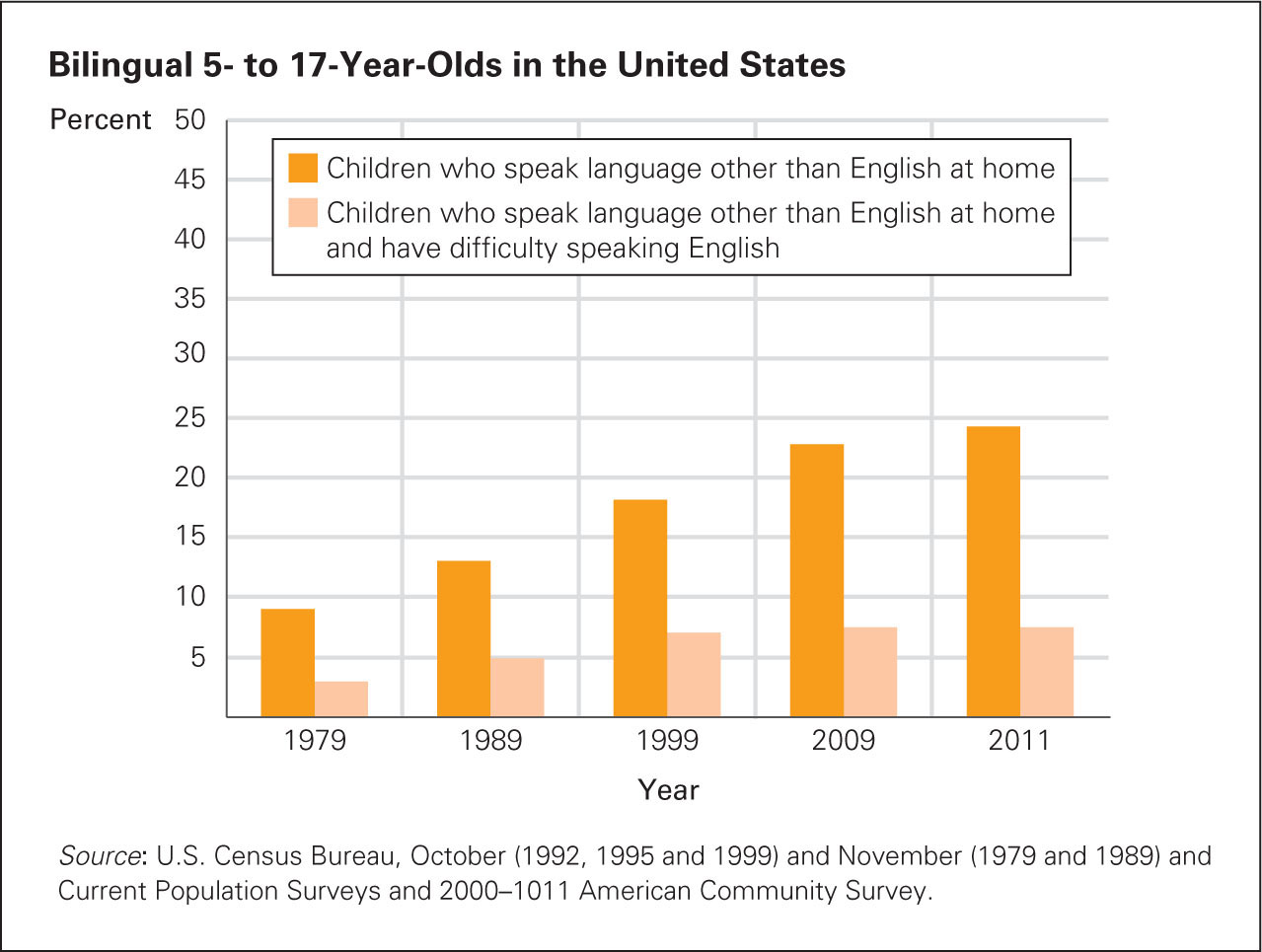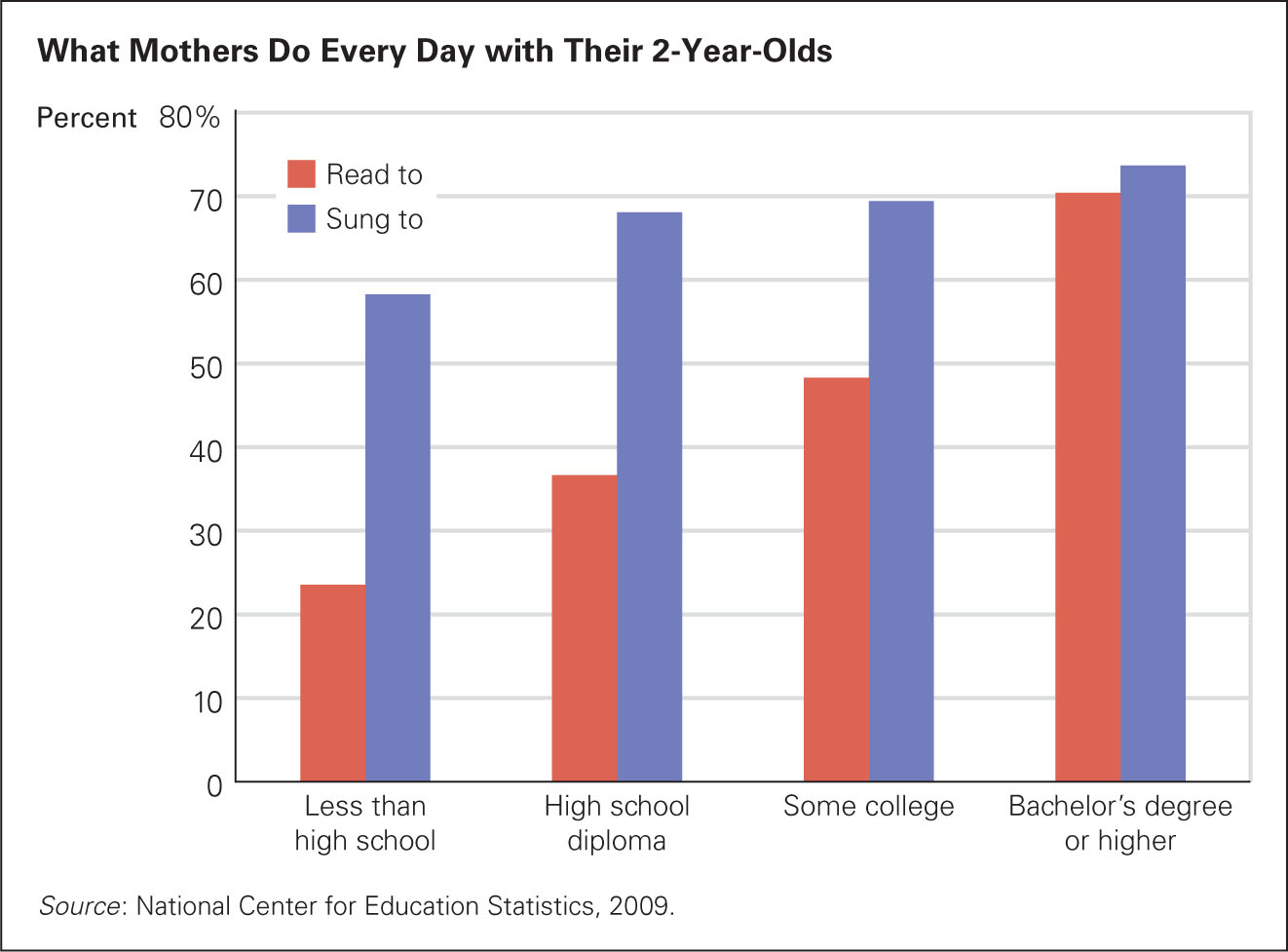12.2 Language
As you will remember, many aspects of language advance during early childhood. By age 6, children have mastered the basic vocabulary and grammar of their first language. Many also speak a second language fluently. Those linguistic abilities form a strong knowledge base, enabling some school-
Vocabulary
By age 6, children know the names of thousands of objects, and they use many parts of speech—
Understanding Metaphors
Metaphors, jokes, and puns are finally comprehended. Some jokes (“What is black and white and read all over?” “Why did the chicken cross the road?”) are funny only during middle childhood. Younger children don’t understand why they provoke laughter, and teenagers find them lame and stale, but the new cognitive flexibility of 6-
349
Indeed, a lack of metaphorical understanding, even if a child has a large vocabulary, signifies cognitive problems (Thomas et al., 2010). Humor, or lack of it, is a diagnostic tool.
Many adults do not realize how difficult it is for young children or adults who are learning a new language to grasp figures of speech. The humorist James Thurber remembered
the enchanted private world of my early boyhood…. In this world, businessmen who phoned their wives to say they were tied up at the office sat roped to their swivel chairs, and probably gagged, unable to move or speak except somehow, miraculously, to telephone…. Then there was the man who left town under a cloud. Sometimes I saw him all wrapped up in the cloud and invisible…. At other times it floated, about the size of a sofa, above him wherever he went…. [I remember] the old lady who was always up in the air, the husband who did not seem able to put his foot down, the man who lost his head during a fire but was still able to run out of the house yelling.
[Thurber, 1999, p. 40]
Especially for Parents You’ve had an exhausting day but are setting out to buy groceries. Your 7-
Response for Parents: Your son would understand your explanation, but you should take him along if you can do so without losing patience. You wouldn’t ignore his need for food or medicine, so don’t ignore his need for learning. While shopping, you can teach vocabulary (does he know pimientos, pepperoni, polenta?), categories (root vegetables, freshwater fish), and math (which size box of cereal is cheaper?). Explain in advance that you need him to help you find items and carry them and that he can choose only one item that you wouldn’t normally buy. Seven-
Metaphors are context specific, building on the knowledge base. An American who lives in China notes phrases that U.S. children learn but that children in cultures without baseball do not, including “dropped the ball,” “on the ball,” “play ball,” “throw a curve,” “strike out” (Davis, 1999). If a teacher says “keep your eyes on the ball,” some immigrant children might not pay attention because they are looking for that ball.
Because school-
is like a jellyfish, which has a deadly sting and vicious bite and tentacles which could squeeze your throat and make your bronchioles get smaller and make breathing harder. Or like a boa constrictor squeezing life out of you.
[quoted in Peterson & Sterling, 2009, p. 97]
That boy was terrified of his disease, which he considered evil and dangerous—
Adjusting Vocabulary to the Context
One aspect of language that advances markedly in middle childhood is pragmatics, already defined in Chapter 9. Pragmatics is evident when we are comparing how children talk formally with teachers (never calling them a rotten egg) and informally with friends (who can be rotten eggs or worse). As children master pragmatics, they become more adept at making friends. Shy 6-

Mastery of pragmatics allows children to change styles of speech, or “linguistic codes,” depending on their audience. Each code includes many aspects of language—
350
Some children may not realize that such expressions are wrong in formal language. All children need instruction to become fluent in the formal code because the logic of grammar (whether who or whom is correct or how to spell you) is almost impossible to deduce. The peer group teaches the informal code, and each local community transmits dialect, metaphors, and pronunciation. Educators must teach the formal code without making children feel that their code’s grammar or pronunciation is shameful.
Code changes are obvious when children speak one language at home and another at school. Every nation includes many such children; most of the world’s 6,000 languages are not school languages. For instance, English is the language of instruction in Australia, but 17 percent of the children speak one of 246 other languages at home (Centre for Community Child Health, 2009).
In the United States, almost 1 school-

Source: U.S. Census Bureau, October (1992, 1995 and 1999) and November (1979 and 1989) and Current Population Surveys and 2000–
ELLs (English Language Learners) Children in the United States whose proficiency in English is low—
Some children of every ethnicity are called ELLs, or English Language Learners, based on their proficiency in English. Among U.S. children with Latin American heritage, those who speak English well are much better at reading than those who do not, but even they are less adept at reading than the average European American child (Garcia & Miller, 2008). Culture may be the reason, as their learning style may not be the same as their teachers’ teaching style, even though they speak English.
The information-
Differences in Language Learning
Learning to speak, read, and write the school language is pivotal for primary school education. Some differences may be innate: A child with a language disability has trouble with both the school and home languages. It is a mistake to assume that a child who does not speak English well is learning disabled (difference is not deficit), but it is also is a mistake to assume that such a child’s only problem is lack of English knowledge (deficits do occur among all children, no matter what their culture).
Nonetheless, most of the language gap between one child and another is the result of the social context, not brain abnormality. Two crucial factors are the family’s SES and everyone’s expectations for the child’s learning.
351
Socioeconomic Status
Decades of research throughout the world have found a strong correlation between academic achievement and socioeconomic status. Language is a major reason. Not only do children from low-
With regard to language learning, the information-
In addition, a child’s early exposure to words has been proven to affect language learning. Unlike most parents who have attended college, many less-

Book reading is not the only way to increase language exposure in children—
Ideally, parents read to, sing to, and converse with each child daily, as well as provide extensive vocabulary about various activities, such as walking down the street: “The sidewalk is narrow [or wide, or cracked, or cement] here. See the wilted rose. Is it red or magenta or maroon? That truck has six huge tires. Why does it have so many?.”
As already noted, slow language development correlates with low income, but language exposure is the likely reason. Indeed, children from high-
Studies that track how much language young children hear from adults find vast differences from one home to another—
352
Expectations
A second cause of low achievement in middle childhood in many nations of the world is teachers’ and parents’ expectations (Melhuish et al., 2008; Phillipson & Phillipson, 2007; Rosenthal, 1991; Rubie-
Recent research has repeatedly found that expectations do not necessarily follow along income lines. For low-
International achievement test scores (discussed in the last section of this chapter) indicate that the income gap and the consequent variations in school resources and student achievement are much greater in some nations than in others. One of the largest gaps is in the United States, where the fourth-
The worst part of adults’ low expectations is that they are transmitted to the child. Schoolchildren who internalize their parents’ or teachers’ expectation that they will not learn much probably won’t learn much. A child’s expectations and motivation (discussed earlier) go hand in hand.
Expectations are crucial at every stage of life. A study of learning among college students found that, after controlling for family background and high school grades, the colleges where professors expected students to study, and who therefore gave longer reading and writing assignments, advanced student learning (Arum & Roksa, 2011). A person’s expectations influence more than just academics: Adults who expect to live a long life take better care of their health. [Lifespan Link: The impact of health habits on longevity is discussed in Chapter 20.]
A CASE TO STUDY
Two Immigrants
Two children, both Mexican American, describe their experiences in their local public school in California.
Yolanda:
When I got here [from Mexico at age 7], I didn’t want to stay here, ’cause I didn’t like the school. And after a little while, in third grade, I started getting the hint of it and everything and I tried real hard in it. I really got along with the teachers…. They would start talking to me, or they kinda like pulled me up some grades, or moved me to other classes, or took me somewhere. And they were always congratulating me.
Paul:
I grew up…ditching school, just getting in trouble, trying to make a dollar, that’s it, you know? Just go to school, steal from the store, and go sell candies at school. And that’s what I was doing in the third or fourth grade…. I was always getting in the principal’s office, suspended, kicked out, everything, starting from the third grade.
[quoted in Nieto, 2000, pp. 220, 249]
Note that initially Yolanda didn’t like the United States because of school, but her teachers “kind of pulled me up.” By third grade, she was beginning to get “the hint of it.” For Paul, school was where he sold stolen candy and where his third-
It would be easy to conclude that the difference was gender, since girls generally do better in school than boys. But that is too simple: Some Mexican-
353
SUMMING UP
Children continue to learn language rapidly during the school years. They become more flexible, logical, and knowledgeable, figuring out the meanings of new words and grasping metaphors, jokes, and compound words. Many converse with friends using informal speech and master formal code in school. They learn whatever grammar and vocabulary they are taught, and they succeed at pragmatics—